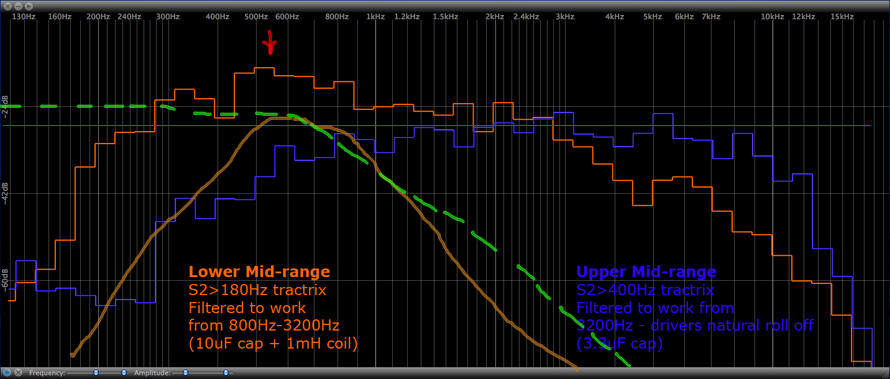Rerurn to Romy the Cat's Site
In the Forum: Horn-Loaded Speakers
In the Thread: Jessie Dazzle Project
Post Subject: Playing around.Posted by Romy the Cat on: 7/8/2008
 jessie.dazzle wrote: jessie.dazzle wrote: |
| And Ok, maybe I don't have all the filters dialed in, and the DPOLS are like a dream to me now…. |
|
And with 1600 pound per channel you might forget about the DPOLS … -
 jessie.dazzle wrote: jessie.dazzle wrote: |
| Here is an RTA plot of both the upper and lower mid horns, as they are currently set up |
|
OK, Jessie, first thing first and I am not kidding – change the way you use RTA. You must not look at 80dB window. You need to found for yourself a reasonable resolution and stick to it. I personally use 1dB you might go higher or lower, but you need to see your .5-1dB very deistically. Use 10dB-16dB window. Now, it is very important to found a convent RTA window and resolution and never change it. The reason is that when you begin to listen it and interpret your measurement you will develop visional-audible relation. So, in order the RTA sweep has any practical since for yourself you need to develop in your head some sensitive of looking at the RTA’s output. So, go for 12dB window and .5dB horizontal markers.
Regarding to the graph itself. Everything looks fine, some adjustments you might consider. I will make general observation encompassing your comments
1) Your must to select for you’re a metal reference level – you must not balance the system abstractedly. The reference level in your case would be the main plot of your MF channel. I marked it Red on your TRA
2) The MF is fine but it has quite strong bottom output down to 500Hz and rolls off too soon at HF. What distance you measured it and how much off axis the mic was? Was Mic calibrated at HF?
3) Since you have a dedicated Fundamental Channels I would cut the bottom response of MF Channels. Go for 2.7-3uF cap making the electrical crossover point around 4K. This will bring the acoustic crossover point of MF to ~ 1000Hz and would save a lot of necessary excursion at MF driver.
4) Bring the Fundamental Channel 3-8dB lower – I do not see at your resolution how much – until the 500-900Hz region hit the Reference Level. Make the band-pass more narrow, decreasing the HF extension from the Fundamental Channel. It will be a coil around 2.7mH that would make 900Hz. But 3 or 4 of then, the cheapest one and then listen the MF and Fundamental Channels combined, while taking the turn out of the coil. Approximately around 2.3mH or 1000-1100Hz you might found it works better. The precession is not too important in there – you can always tine-tine the Fundamental Channel with changing volume of the Channel – a good 16R LPAD would help a lot. Do not forget that Fundamental Channels is the body of sound – you will fine adjust it later on. The proposed ideal response of the Fundamental Channels I drew in yellows on the graph. In practice it might be even 5-4dB lover then this – and not to me measurable at all (hidden behind MF and upperbass output). Sonically, however that not-measurable weight will be there and do its duty. I use disconnect the upperbass and MF to get the Fundamental Channel profile.
5) Find what to cross your Fundamental Channel at the bottom. It will depend how much your horn will tolerate without being choked with honk. Do not forget that at the range of the Fundamental Channel’s bottom knee the room maters.
6) The prospect upper bass woe reaps is show with green dashes…

The caTRerurn to Romy the Cat's Site